Key Insights
- Storage utilization increased from 25% in Q2’23 to 29% in Q3’23. Despite the 12% fall in active storage contracts, renters stored 4% more data per contract in Q3 than in the previous quarter.
- New storage contracts fell by 13% QoQ. As the number of developers across the crypto space continues to drop QoQ, it lowers Sia’s primary consumer base for storage contracts.
- Increased demand for storage combined with QoQ price increases in the USD value of storage (+21%) and bandwidth (+12% for upload and +15% for download) led demand-side revenue to rise 15% QoQ, despite an 11% drop in the price of SC.
- The Sia Foundation approved four grants throughout Q3’23 for a total of $52,000, with the largest being $42,000 and the smallest being $1,500.
Primer on Sia
Sia is a decentralized cloud storage network that combines a Proof-of-Work blockchain with a contract-based storage model. Storage contracts are used to uphold storage agreements between hosts and renters. Renters define the amount of data to be stored, the timeframe for storage, and the price.
As users and storage providers enter into storage contracts, they each deposit the native asset — Siacoin (SC) — into an escrow account. Storage providers must cryptographically prove they are hosting the required data, and if they do not uphold the storage agreement, their collateral is slashed. At contract expiry, the storage provider receives the majority of the escrowed funds, with a small portion (3.9%) going to holders of Siafund (SF) tokens. Siafunds are security tokens that accrue SC to the SF holder from finished contracts on Sia.
Sia facilitates a global data storage marketplace by connecting storage providers (hosts) with underutilized hard drive capacity to storage consumers (renters). Siacoin can be used to pay for gas on the Sia blockchain and as the medium of exchange for the storage market. Renters pay a storage fee, upload/download bandwidth prices, and gas for the creation of storage contracts.
Files stored on the Sia network are encrypted via ChaCha20 and stored redundantly via Reed–Soloman Erasure Coding. The encryption aspect ensures that uploaded files remain private, and redundancy ensures security by sharding files. Files uploaded to Sia are split into 30 chunks, or shards, and sent to various hosts. Only 10 shards are required to rebuild the file, and their copies are re-duplicated to new hosts whenever one is offline.
Sia was conceived at HackMIT in 2013 and launched in 2015 by Nebulous Inc., which later split into two entities: the Sia Foundation and Skynet Labs. The Sia Foundation launched after a successful hardfork of the Sia blockchain, which introduced an SC token subsidy to fund the foundation. In April 2021, Nebulous announced its full rebrand to Skynet Labs. It started to reduce its services in August 2022, shutting down its portals in early November 2022 due to a lack of funding. Despite the shutdown of Skynet Labs, Sia continues to operate and implement new developments under the Sia Foundation. For a full primer on Sia, refer to our Initiation of Coverage report.
Key Metrics
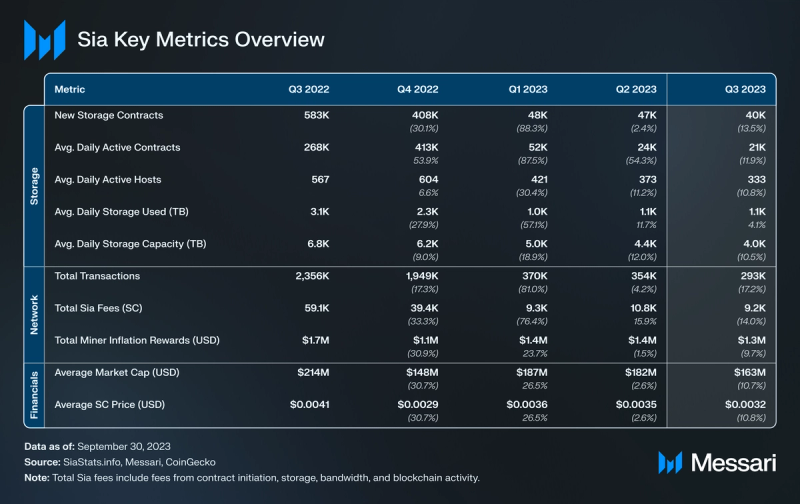
Performance Analysis
Active Contracts
When a contract is active, it means that the contract is automatically facilitating the exchange between escrowed SC and storage provided by hosts.
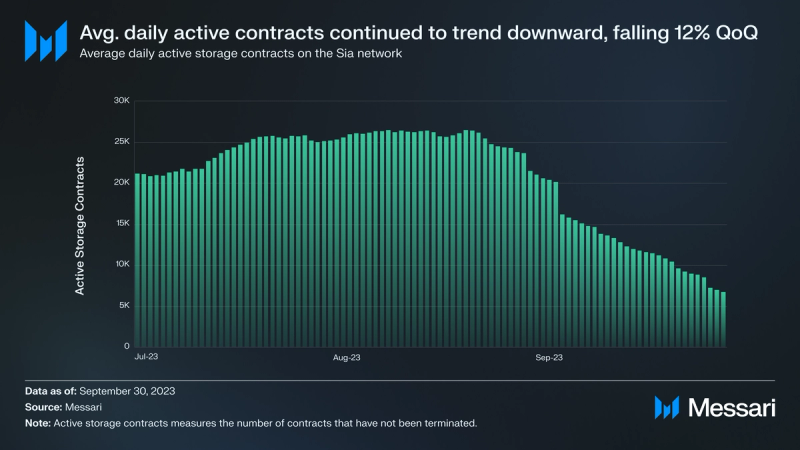
Since peaking in October 2022, active contracts have declined each quarter. Following a 54% decrease in Q2’23, the average number of active contracts fell by 12% QoQ. The number of full-time and part-time developers across the crypto space continues to drop QoQ as well, lowering Sia’s primary consumer base for storage contracts.
Compounding the bear market sentiment and exodus of developers, the initial drops in active contracts also resulted from problems with third-party interfaces that created storage contracts for Sia users. To address this issue, the Sia Foundation launched a beta version of a web interface (renterd) that enables users to create storage contracts on Sia, removing the reliance on third parties.
Transactions and New Contracts
Transactions on Sia account for all activity related to:
- storage contracts,
- peer-to-peer transfers, and
- trades of the SC asset.
New storage contracts are a measure of the origination of active storage contracts. New contracts require renters to allocate funds (called allowances) in advance that determine how much SC they are willing to pay for storage on Sia. The allowance is derived from an equation that multiplies the price in SC per TB stored by the expected number of TBs and by the expected number of months for storage. For example, if a user wanted to store 3 TB of data for 3 months at a price of 500 SC per TB, their allowance would be 4,500 SC (500 x 3 x 3). Renters also pay contract formation and upload bandwidth fees when creating new contracts. Hosts must also lock up collateral, which can be slashed if they don’t uphold the contract agreement.
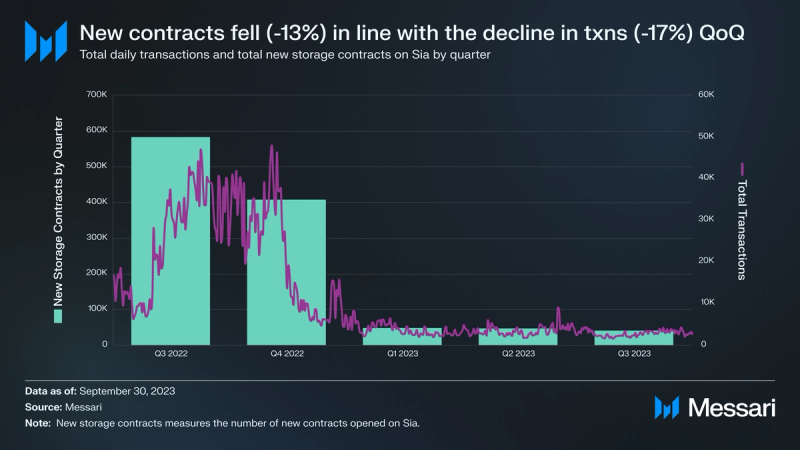
The creation of new contracts spurs various types of transactions on Sia like contract initiation payments, bandwidth payments, and ongoing storage payments. Hence, the performance of new contracts is likely also reflected in transactions. Because of the network effects of starting a new contract, the total number of transactions should experience a slightly larger movement than that of the number of new contracts. As expected, in Q3, newly issued contracts fell by 13% and total transactions fell by 17%.
These drops in new contracts and transactions follow the downward momentum from previous quarters, going back to the 30% QoQ decline in new contracts from Q4’22. Similar to active contracts, the number of new contracts is also influenced by the size of the Web3 developer pool and the current market sentiment’s effects on decentralized application development.
Storage Utilization
While the capacity of a storage network helps highlight its current scale, its utilization rate reveals the demand for the type of storage it optimizes for. Sia operates in the hot storage market, primarily targeting developers. It’s favored by those in search of a decentralized storage system offering both privacy and fast retrieval.
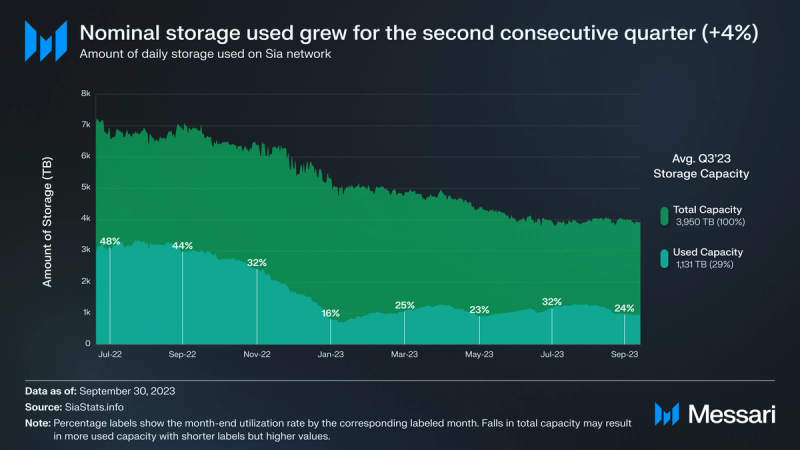
Sia uses a Stake-for-Access (SFA) token model to capture value and provide storage. In this model, utilized storage is achieved through storage contracts. Despite another QoQ fall in new contracts (-13%), storage used increased by 4% QoQ. Although fewer storage contracts were created, users appear to be storing larger files per contract on average. On the supply side, storage capacity dropped by 11% QoQ, with similar falls in the past three quarters. The fall in capacity with the rise in utilization led the average utilization rate to increase by 4% QoQ, up to 29%.
Storage Prices
Renters entering a storage contract on Sia pay multiple fees to set up and maintain the contract. Storage fees are a product of the amount of data uploaded, the length of time of the contract, and the price in SC per TB per month.
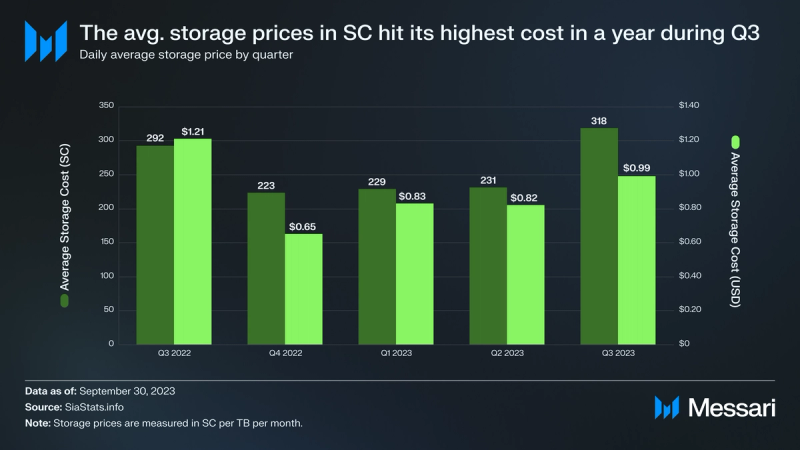
Average daily storage prices in SC during Q3 had the largest QoQ movement (+38%) in a year. A partial driver for this movement may be the 11% drop in the SC price QoQ. It may also be affected by the increase in storage utilization, lessening the (albeit plentiful) amount of open storage on Sia.
Bandwidth Costs
Storage providers offload the costs of uploading and downloading the renter’s data to the individual renter. Users seeking to store data on Sia initially pay upload fees to hosts, and users seeking to retrieve uploaded data pay download fees to hosts. In both cases, bandwidth is priced per TB.
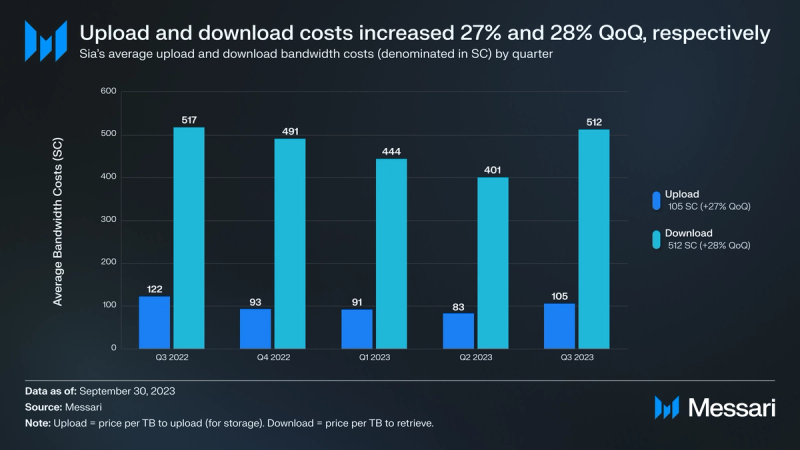
Upload and download bandwidth prices increased by 27% and 28% QoQ, respectively, following consecutive decreases in bandwidth prices over the previous three quarters. The uptick in bandwidth prices aligns with the decline in the USD value of SC and the increase in storage utilization. This decrease in the USD value of SC, coupled with a tightening supply of storage, provides storage providers with an incentive to raise prices. Doing so would help sustain revenue in USD terms and adapt to a product with a more restricted supply.

The USD price for bandwidth moved in the opposite direction when compared to the price of SC. While SC’s price decreased by 11%, the USD prices for upload and download bandwidth increased by 12% and 15%, respectively. They were primarily influenced by the growth in bandwidth measured in SC terms. This rise in the USD price for bandwidth, coupled with the nominal growth in the amount of storage being used, provided some relief to storage providers amid the declining USD price of SC.
Transaction Fee Price
As a Proof-of-Work blockchain, transaction fees on Sia are paid to miners who maintain the blockchain’s state and approve new transactions.
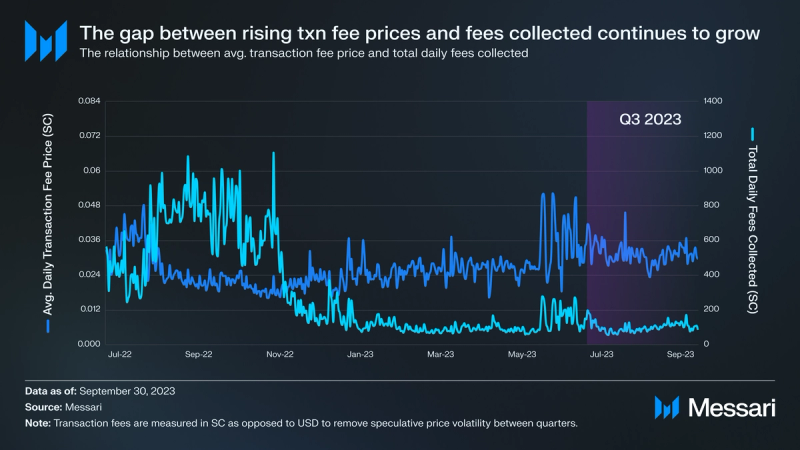
The average daily transaction fee mirrored the pricing trends of Sia’s storage and bandwidth fees. It reached its highest point in the past year during Q3, with a 5% increase to $0.031. This increase may be attributed to the rising cost of new contracts due to larger file sizes, given nominal used storage increased while new contracts decreased QoQ. Maintaining the inverse relationship that began in Q4’22, miners saw a 15% QoQ decrease in daily fees collected. The decrease corresponds to a decline in activity reflected by a 13% QoQ decrease in new contracts.
Network Revenue
Sia produces revenue for multiple parties: hosts, miners, and Siafund (SF) holders. Its network revenue is the sum of payouts to hosts, Siafund fees, miner fees, and burned collateral. Burned collateral is included in revenue because burning SC makes it more scarce and theoretically accrues value to SC holders.
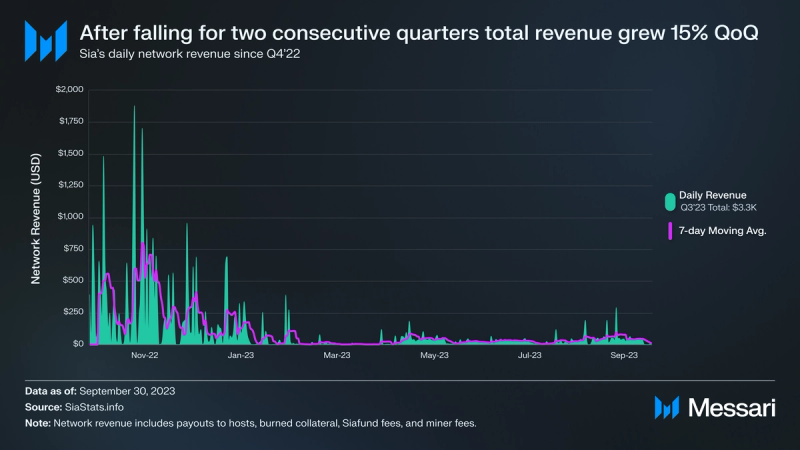
Sia’s network revenue grew 15% QoQ, following the upward direction of nominal storage used (+4%), storage prices in USD (+21%), and bandwidth costs in USD (+12% for upload and +15% for download). Despite corresponding to the change in storage contracts in previous quarters, the utilization of more storage combined with increasing prices led to a jump in network revenue during Q3, reaching $3,200.
Block Rewards in USD
Siacoin has an unlimited maximum supply; its current supply is over 51.5 billion SC. Siacoin inflates at 30,000 SC per block mined, which equated to an annual inflation of ~3.3% in 2022. Since the start of 2023, annual inflation has hit ~0.2% (annualized). Over time, this rate will approach, but never reach, 0%. Because a portion of SC must be locked up in storage contracts, Siacoin’s inflation mechanism operates to maintain liquidity.
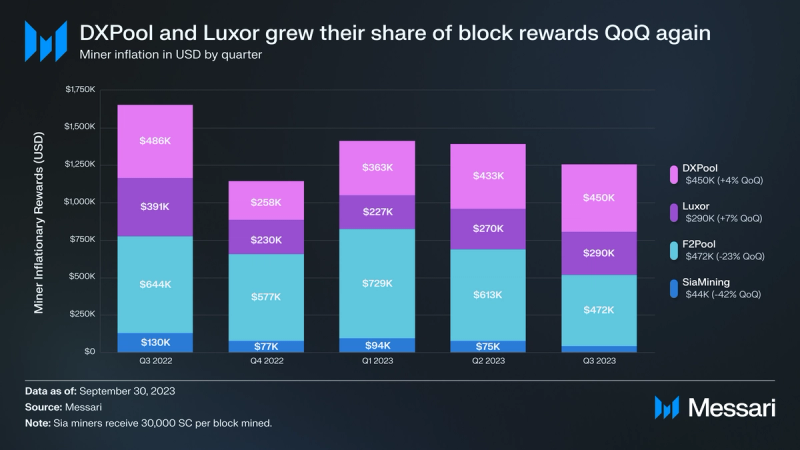
Sia’s largest and smallest miners (F2Pool and SiaMining) experienced QoQ decreases in inflationary block rewards in USD, -23% and -42% QoQ, respectively. Meanwhile, Luxor and DXPool grew their earnings of block rewards again, gaining 7% and 4% QoQ, respectively.
Percentage of Blocks Mined by Pool
The percentage of blocks mined by each mining pool shows how dominant certain entities are in block creation on Sia.
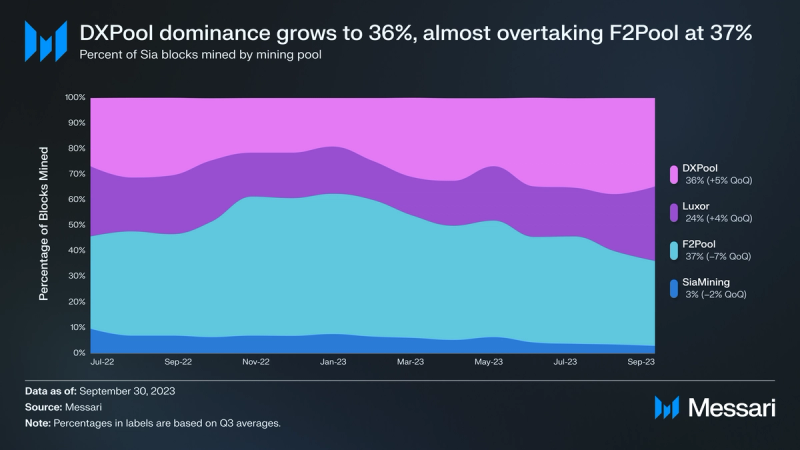
Since F2Pool’s +50% dominance in Q4’22 and Q1’23, it has nearly lost its dominant market position in Sia mining. During Q3, DXPool almost overtook F2Pool, gaining 5% of the market share QoQ while F2Pool lost 7% of its share QoQ. DXPool finished the quarter with 36% of market share. Since Q1’23, Sia’s mining market share has become more widely distributed. That said, the SiaMining pool has consistently experienced declines throughout the year, dropping to only 3% of the mining share in Q3.
Market Cap & Price
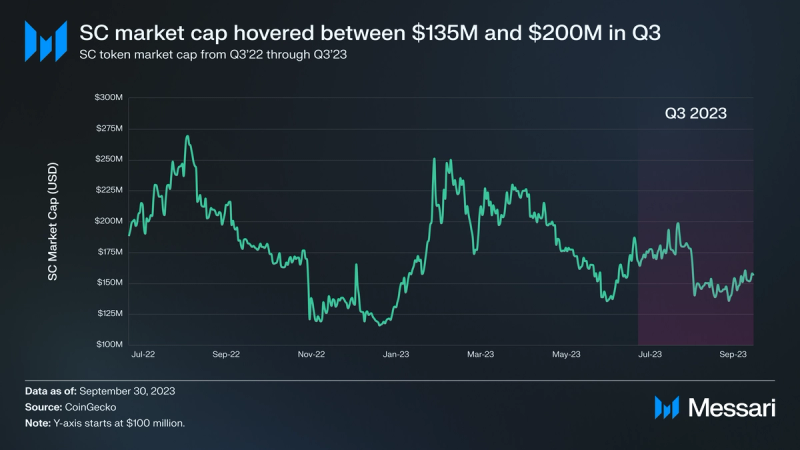
Sia’s Stake-for-Access (SFA) token model requires hosts and renters to lock up SC in order to accept storage deals. The more SC hosts lock up, the more data they can store. The resulting dynamic forces storage providers to increase their collateral as they store more data, thus increasing demand for the network’s native asset. In theory, the asset’s price should increase with the amount of data stored on the network and vice versa.
Although both storage utilization and nominal storage increased by 4% QoQ, the price of SC followed the broader market, decreasing by 11% QoQ. Should the protocol see increased usage, network activity may hold a larger influence over the price of SC.
Qualitative Analysis
Grants
The Sia Foundation approved four grants that accounted for $52,000 in Q3’23. Since its inception, the grant program has approved a total of ~$912,000 for projects spanning from development to research. The grants committee meets bi-weekly and consists of six members: three employees of the Sia Foundation and three Sia community members. The four approved grants from Q3’23 are detailed below.
ARC Data Wallet – $42,000
The Sia Foundation approved $42,000 for Bela Supernova to build the ARC Data Wallet, a browser extension for users to manage their Sia wallet and files. This wallet will open access to Sia on any device without the need to download and sync Sia’s UI client, lowering the barriers to entry for less technical users.
Sia Proxmox Backup Feasibility Study – $6,000
The Sia Foundation approved $6,000 for A-Z Computer Solutions to conduct a feasibility study to examine the possibility of integrating Sia as a storage medium for Proxmox backups. A-Z Computer Solutions will attempt to build an open-source module that will allow Proxmox’s backup servers to back up to cloud platforms.
Proxmox backups refer to the backup solutions provided within the Proxmox Virtual Environment (PVE), a server virtualization environment. Proxmox allows administrators to take snapshots and back up virtual machines, containers, and the Proxmox host system. Doing so ensures data integrity and recovery in case of data loss, hardware failure, or other unforeseen issues. If the study demonstrates that Sia is a viable storage medium for Proxmox backups, A-Z Computer Solutions will submit a follow-up grant proposal to develop the project being examined.
hostd Monitoring Service – $2,500
The Sia Foundation approved $2,500 for Michał Maj to build a service called Sia Heartbeat that notifies Sia hosts when their host node goes offline. Sia Heartbeat will enable hosts to receive notifications via email or SMS messages. This project seeks to add robustness and reliability to hosting services on Sia.
hostd Prometheus Exporter – $1,500
The Sia Foundation approved $1,500 for a community member named javierxam to build an exporter tool that will collect hostd data with Prometheus and create graphs in Grafana. While the siad module already has an exporter, this project aims to provide hosts with a way to monitor their nodes using tools from Prometheus and Grafana.
Development Roadmap
Sia has run as a functional blockchain and storage network since 2015 and has undergone several network developments in the past eight years. Sia’s recent developments largely focus on giving network participants a better user experience. The key roadmap items are a continuation from Q1 and Q2. The Sia Foundation continues to implement new features on top of existing modules and prepare them for the upcoming hard fork. The new features added to existing modules are listed below.
- renterd
- Support for the S3 object storage API: increases the compatibility of renterd and enables integration with many different applications.
- Support for webhooks: enables app integrations like a Discord bot that can ping users when their wallet balance drops below a certain threshold.
- Upload packing: reduces the overhead of storing small files.
- hostd
- Addition of revenue metrics: enables hosts to better manage node operations based on resources and revenue.
- Development on making hostd hard fork compatible: Sia plans to conduct a hard fork around Q2 of next year.
- explorer
- SiaScan: Sia Foundation deployed a new explorer that will be equipped to handle the forthcoming changes that will result from the pending hard fork.
Closing Summary
The Sia network continued to support more storage use (+4%) throughout the quarter despite seeing falls in active contracts (-12%), newly issued contracts (-13%), and total transactions (-17%). Despite an 11% drop in the price of SC, revenue rose 15% QoQ, given the increased demand for storage combined with QoQ price jumps in the USD value of storage (+21%) and bandwidth (+12% for upload and +15% for download).
The decline in Sia’s usage metrics (despite storage utilization) follows broader trends across the market, especially as Web3 developers (its primary consumer base) broadly continue to leave crypto. While bull markets seem to cure most issues, Sia’s usage will depend on developers re-entering the crypto space. Given its status as the longest operating storage network in crypto, developers in need of a reliable hot storage option might opt for Sia, especially for applications that prioritize privacy and rapid data retrieval.
——



















